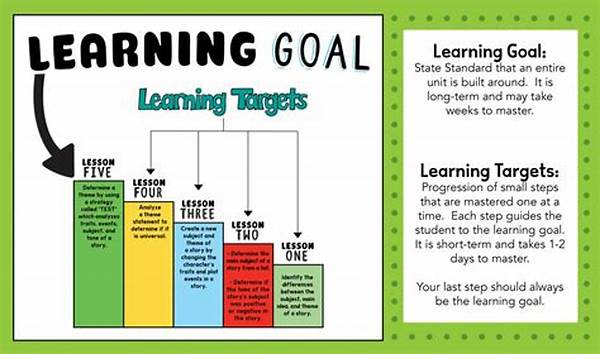In the realm of education, the concept of tailoring learning objectives to the individual needs and capabilities of each student has gained substantial recognition. Student-specific learning goals serve as a pivotal component in personalizing education, ensuring that learners are both challenged and supported according to their unique potentials and interests. By adopting this approach, educators can address the diverse learning paces and styles present in the classroom, thereby fostering an environment conducive to optimal student achievement.
Read Now : Needs-based Educational Program Design
The Importance of Individualization in Education
Student-specific learning goals emphasize individualized learning pathways that accommodate various student profiles within a classroom. This approach recognizes that each student’s learning journey is distinct, influenced by factors such as prior knowledge, learning style, and personal interests. By establishing student-specific learning goals, educators can tailor their instructional strategies to meet the particular needs of each learner, ensuring personalized attention and support.
This educational model encourages the formulation of clear, attainable objectives that are aligned with each student’s capabilities. By doing so, teachers can better engage students, increasing their motivation and investment in the learning process. This approach not only improves academic outcomes but also nurtures essential skills such as critical thinking, problem-solving, and self-regulation. Ultimately, student-specific learning goals facilitate a more inclusive and equitable educational landscape.
Characteristics of Student-Specific Learning Goals
1. Personalization: Student-specific learning goals are tailored to each student’s unique needs and learning preferences. This customization allows learners to progress at their own pace, thereby enhancing engagement and retention.
2. Measurability: These goals are designed to be measurable, providing a clear benchmark for assessing student progress and development. This enables both educators and learners to track achievements effectively.
3. Attainability: Student-specific learning goals must be realistic and achievable, taking into account the starting point and potential of each student. This ensures that goals remain challenging yet within reach, fostering a sense of accomplishment.
4. Relevance: The objectives established are relevant to the student’s interests and future aspirations, thereby aligning academic pursuits with long-term goals. This relevance enhances the learner’s intrinsic motivation.
5. Flexibility: The adaptability of student-specific learning goals allows them to evolve in response to the student’s growing knowledge and capabilities, ensuring continuous relevance and challenge.
Implementing Student-Specific Learning Goals
Educators who wish to integrate student-specific learning goals into their teaching strategies must first conduct comprehensive assessments to understand the varying needs and strengths of their students. This exploratory phase sets the foundation for designing tailored objectives that align with individual student profiles. Continuous evaluation plays a crucial role in this process, enabling educators to recalibrate goals as students progress and develop.
Read Now : Regular Feedback And Progress Tracking
The implementation of student-specific learning goals empowers students to take ownership of their learning journeys, fostering independence and self-advocacy. This approach also encourages reflective practices, where students actively engage in self-assessment and goal setting, gaining critical insights into their learning processes. By emphasizing active participation, educators can cultivate lifelong learners equipped with the skills needed to navigate an ever-evolving academic and professional landscape.
Benefits of Student-Specific Learning Goals
The adoption of student-specific learning goals yields multiple benefits, both for learners and educators. For students, this approach provides opportunities for personalized learning that acknowledges their individual strengths and preferences. It enhances confidence and motivation, as learners are more likely to succeed when objectives are aligned with their abilities and interests. Additionally, the focus on customization fosters a deeper understanding of academic content and promotes skill mastery.
Moreover, educators benefit from implementing student-specific learning goals by fostering a more dynamic and responsive classroom environment. This strategy allows teachers to design more effective instructional methodologies, accommodate diverse student populations, and address potential learning gaps early in the educational journey. Ultimately, student-specific learning goals serve as a foundation for a more adaptive and inclusive educational structure.
Challenges and Solutions
Despite the advantages, implementing student-specific learning goals can pose challenges, such as increased workload for educators due to the need for personalized planning and feedback. Balancing curriculum standards with individual objectives may also present difficulties. However, these challenges can be mitigated by leveraging educational technology and collaborative planning processes, enabling more efficient management of personalized educational practices.
Educators can utilize data-driven tools to streamline the assessment and monitoring of student progress, allowing for timely interventions and adjustments. Additionally, professional development opportunities can equip teachers with the skills necessary to effectively implement and manage student-specific learning goals. By adopting a collaborative approach, educators can share best practices and resources, creating a supportive community committed to enhancing student outcomes through individualized learning approaches.
Conclusion
In summary, student-specific learning goals offer a formidable strategy for addressing the diverse learning needs present in today’s educational environment. By individualizing objectives, educators can accommodate varying student profiles, enhancing engagement and fostering a more inclusive classroom. While challenges exist, the integration of technology and collaborative practices facilitates the efficient implementation of these goals. Ultimately, student-specific learning goals serve as a valuable tool in the pursuit of educational excellence.
